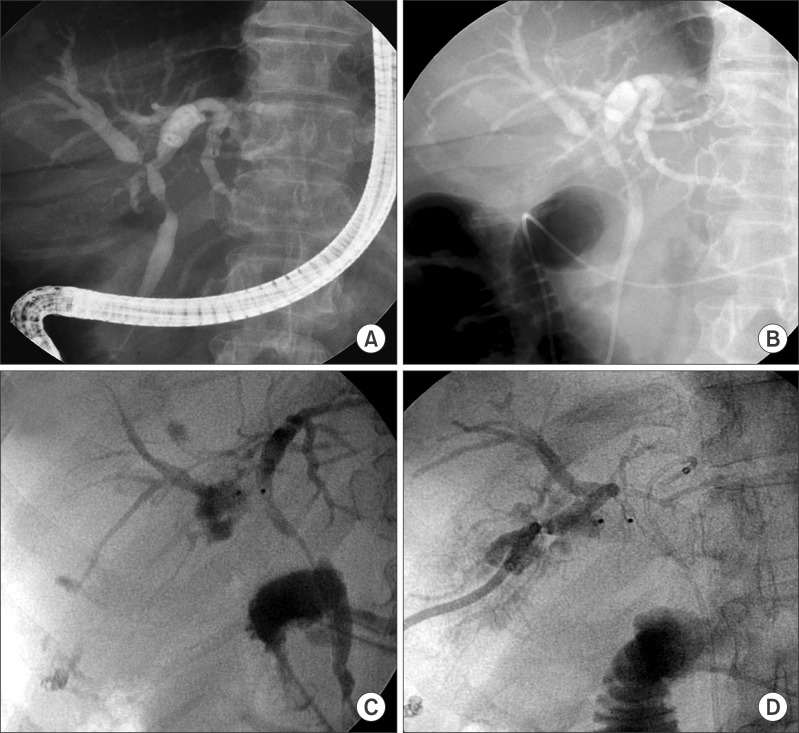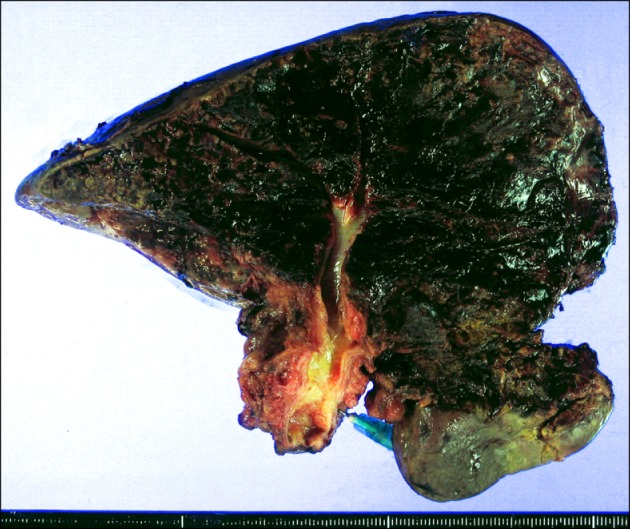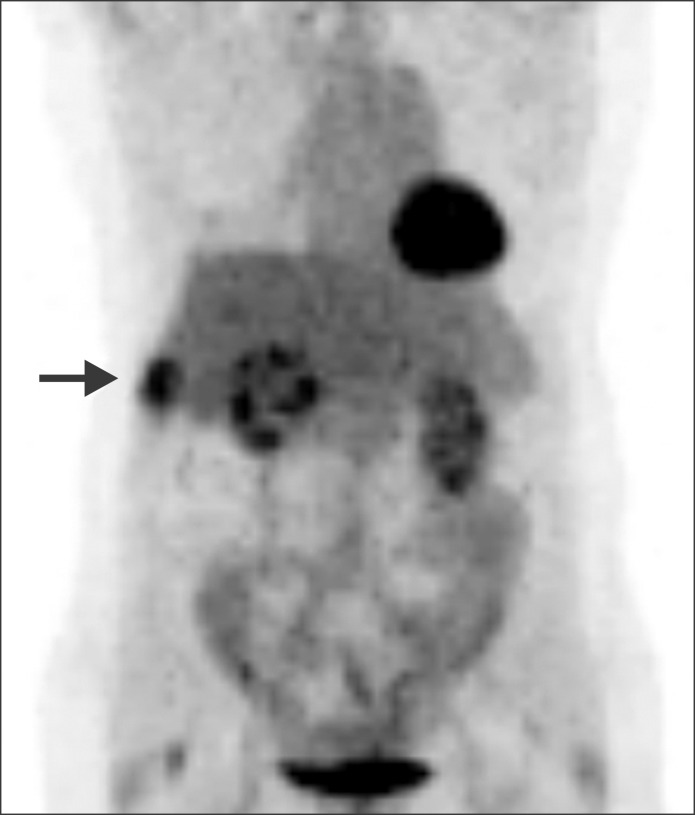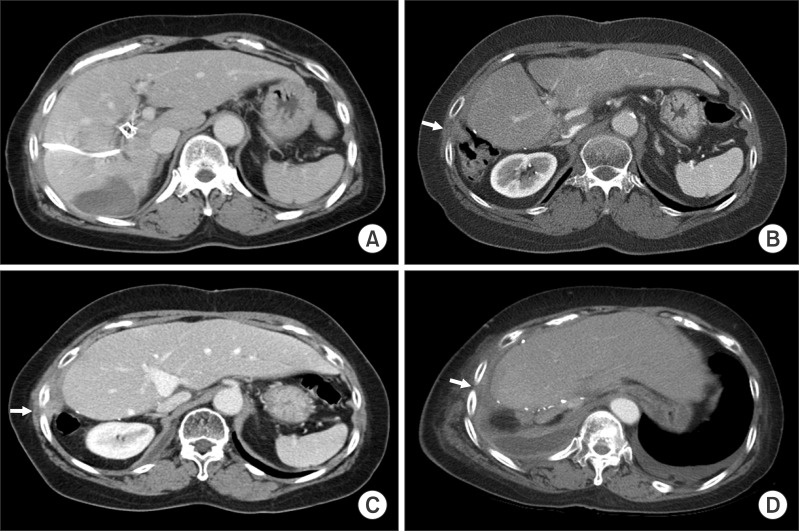Korean J Hepatobiliary Pancreat Surg.
2011 Aug;15(3):179-183. 10.14701/kjhbps.2011.15.3.179.
Solitary percutaneous transhepatic biliary drainage tract metastasis after curative resection of perihilar cholangiocarcinoma: report of a case
- Affiliations
-
- 1Department of Surgery, Asan Medical Center,University of Ulsan College of Medicine, Seoul, Korea. shwang@amc.seoul.kr
- 2Department of Diagnostic Imaging, Asan Medical Center,University of Ulsan College of Medicine, Seoul, Korea.
- 3Department of Internal Medicine, Asan Medical Center,University of Ulsan College of Medicine, Seoul, Korea.
- KMID: 2130990
- DOI: http://doi.org/10.14701/kjhbps.2011.15.3.179
Abstract
- Percutaneous transhepatic biliary drainage (PTBD) has been widely used, but it has a potential risk of tumor spread along the catheter tract. We herein present a case of solitary PTBD tract metastasis after curative resection of perihilar cholangiocarcinoma. Initially, endoscopic nasobiliary drainage was done on a 65 year-old female patient, but the cholangitis did not resolve. Thus a PTBD catheter was inserted into the right posterior duct. Right portal vein embolization was also performed. Curative surgery including right hepatectomy and bile duct resection was performed 16 days after PTBD. After 12 months, serum CA19-9 had increased gradually without any symptoms. Finally, a small right pleural metastasis was found through strict tumor surveillance for 6 months. Chemoradiation therapy was performed, but there was no response to treatment. As the tumor progressed, she complained of severe dyspnea and finally died from tumor dissemination to the chest and bones 18 months after the first detection of PTBD tract recurrence and 36 months after surgery. No intra-abdominal recurrence was found until the terminal stage. This PTBD tract recurrence was attributed to the PTBD even though it was in place for only 16 days. Although such recurrence is rare, its risk should be taken into account during follow-up of patients who have received PTBD before.
Keyword
MeSH Terms
Figure
Reference
-
1. Takahashi Y, Nagino M, Nishio H, Ebata T, Igami T, Nimura Y. Percutaneous transhepatic biliary drainage catheter tract recurrence in cholangiocarcinoma. Br J Surg. 2010; 97:1860–1866. PMID: 20799295.
Article2. Maguchi H, Takahashi K, Katanuma A, et al. Preoperative biliary drainage for hilar cholangiocarcinoma. J Hepatobiliary Pancreat Surg. 2007; 14:441–446. PMID: 17909711.
Article3. Arakura N, Takayama M, Ozaki Y, et al. Efficacy of preoperative endoscopic nasobiliary drainage for hilar cholangiocarcinoma. J Hepatobiliary Pancreat Surg. 2009; 16:473–477. PMID: 19300895.
Article4. Lee SG, Lee YJ, Park KM, Hwang S, Min PC. One hundred and eleven liver resections for hilar bile duct cancer. J Hepatobiliary Pancreat Surg. 2000; 7:135–141. PMID: 10982605.
Article5. Lee SG, Song GW, Hwang S, et al. Surgical treatment of hilar cholangiocarcinoma in the new era: the Asan experience. J Hepatobiliary Pancreat Sci. 2010; 17:476–489. PMID: 19851704.
Article6. Hwang S, Lee SG, Ko GY, et al. Sequential preoperative ipsilateral hepatic vein embolization after portal vein embolization to induce further liver regeneration in patients with hepatobiliary malignancy. Ann Surg. 2009; 249:608–616. PMID: 19300228.
Article7. Shorvon PJ, Leung JW, Corcoran M, Mason RR, Cotton PB. Cutaneous seeding of malignant tumours after insertion of percutaneous prosthesis for obstructive jaundice. Br J Surg. 1984; 71:694–695. PMID: 6478159.
Article8. Tersigni R, Rossi P, Bochicchio O, et al. Tumor extension along percutaneous transhepatic biliary drainage tracts. Eur J Radiol. 1986; 6:280–282. PMID: 3792324.9. Contractor FM, Sharma P, Dash N, Lupetin AR, Schapiro RL. Extension of hepatic metastatic tumor along a biliary drainage catheter tract: case report. Cardiovasc Intervent Radiol. 1987; 10:303–304. PMID: 2960453.10. Chapman WC, Sharp KW, Weaver F, Sawyers JL. Tumor seeding from percutaneous biliary catheters. Ann Surg. 1989; 209:708–713. PMID: 2658881.
Article11. Loew R, Dueber C, Schwarting A, Thelen M. Subcutaneous implantation metastasis of a cholangiocarcinoma of the bile duct after percutaneous transhepatic biliary drainage (PTBD). Eur Radiol. 1997; 7:259–261. PMID: 9038127.
Article12. Inagaki M, Yabuki H, Hashimoto M, et al. Metastatic seeding of bile duct carcinoma in the transhepatic catheter tract: report of a case. Surg Today. 1999; 29:1260–1263. PMID: 10639708.
Article13. Uenishi T, Hirohashi K, Inoue K, et al. Pleural dissemination as a complication of preoperative percutaneous transhepatic biliary drainage for hilar cholangiocarcinoma: report of a case. Surg Today. 2001; 31:174–176. PMID: 11291716.
Article14. Shimizu Y, Yasui K, Kato T, et al. Implantation metastasis along the percutaneous transhepatic biliary drainage sinus tract. Hepatogastroenterology. 2004; 51:365–367. PMID: 15086160.
- Full Text Links
- Actions
-
Cited
- CITED
-
- Close
- Share
- Similar articles
-
- Subcutaneous Implantation Metastasis of a Cholangiocarcinoma of the Bile Duct after Percutaneous Transhepatic Biliary Drainage (PTBD)
- A Comparison of Preoperative Biliary Drainage Methods for Perihilar Cholangiocarcinoma: Endoscopic versus Percutaneous Transhepatic Biliary Drainage
- Spontaneous rupture of intrahepatic bile duct following portal vein embolization in a patient with perihilar cholangiocarcinoma: a case of successful curative resection
- Percutaneous transhepatic biliary drainage
- Gallbladder neck cancer and perihilar cholangiocarcinoma - siblings, cousins or look alikes?





